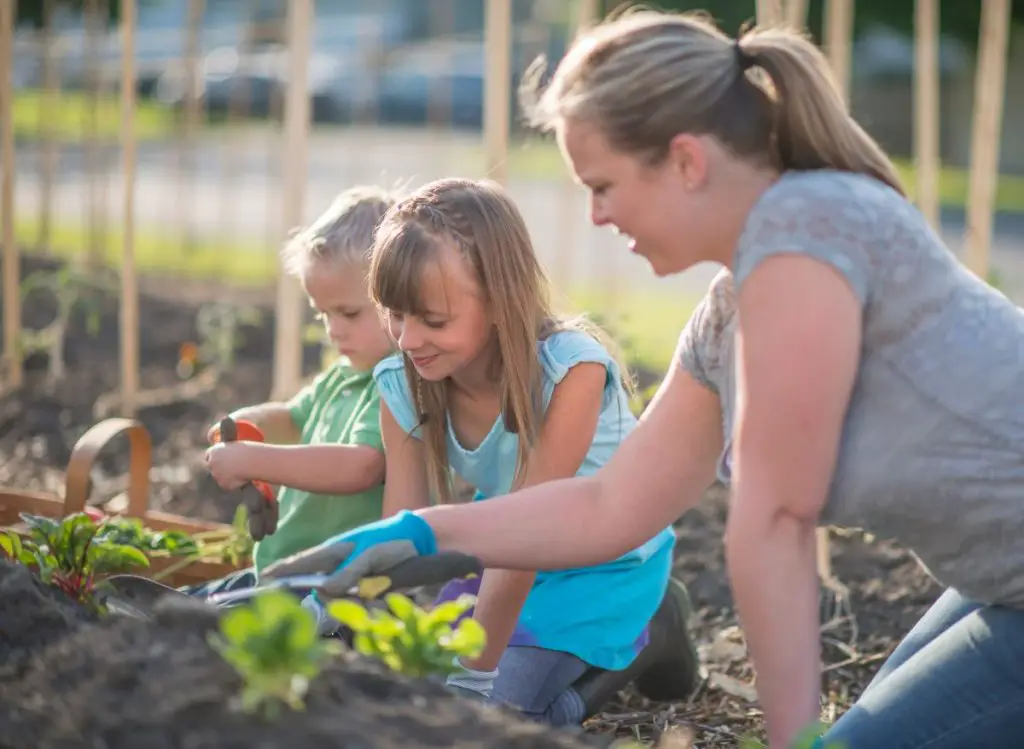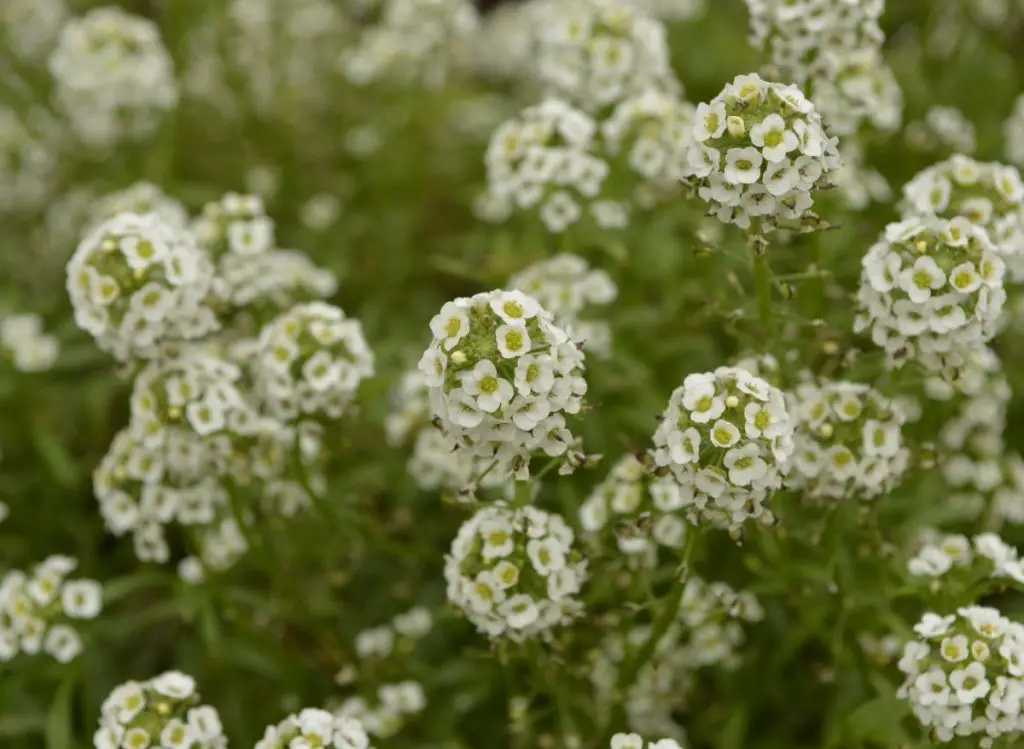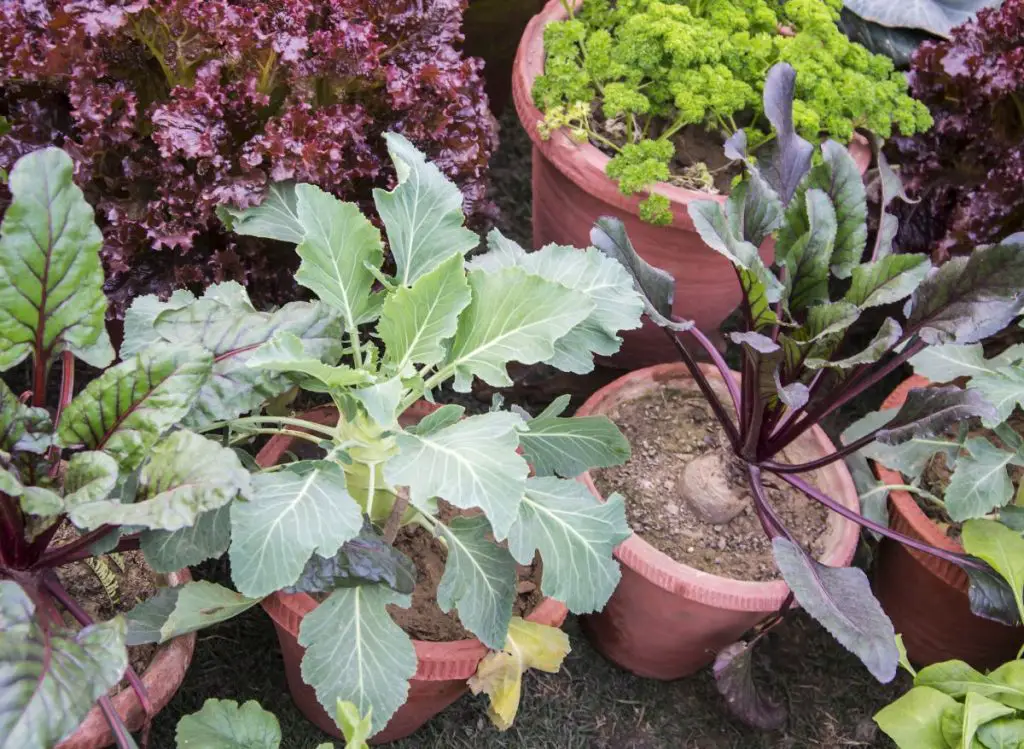
Swiss chard (Beta vulgaris L. var. cicla) is a cool season member of the beet family. It is well-known for its large tasty leaves and colorful stems. The edible stems grow in a variety of colors, like purple, white, and red. The colorful stems add a pop of color and increase nutritional value to any recipe.
Swiss chard is easy to grow in the home garden and has several companion plants that will help it thrive naturally. While the leafy green has many good companion plants, there are a few plants that should never be grown around it.
Read on to discover the best companion plants for Swiss chard and how they help the plant grow. You will also discover the garden plants that should never be planted near Swiss chard and why.
You might also enjoy reading: 19 Fall Vegetables To Grow In Pots (And Helpful tips on caring for each!)
What Is Companion Planting?
Companion planting is planting a variety of different crops together for mutual benefit (Source: West Virginia University). Every plant has at least one companion that will help it grow and be productive. Knowing which plants make the best companions and planting them near each other will give your garden a better chance of success.
Companion planting creates a beneficial garden environment that enables all the plants to thrive. All plants bring something beneficial to the garden. Some repel bad pests, while others attract good pests.
Some plants increase soil nutrients, some improve the structure of the soil, tall plants provide shade from the afternoon sun to shorter plants, and plants with tall, sturdy stalks provide an organic trellis for vining plants to grow up on.
Here is a list of the best companions for Swiss chard. Some of these are probably already a family favorite, so you won’t be sacrificing garden space just to grow a companion for the leafy green vegetable.
The list also includes the garden vegetables that should never be grown Swiss chard.
See also: 13 Effective Zucchini Companion Plants To Try Now!
Companion Plants For Swiss Chard
If you are looking to grow Swiss chard in your garden, consider planting the following companion plants to help your Swiss chard grow healthy and strong.
Here are the best companion plants for Swiss shards:
1- Brussels Sprouts
Brussels sprouts (Brassica oleracea var. gemmifera) are members of the cabbage family. In addition, brussels sprouts have a shallow root system, so they won’t compete for the moisture and nutrients that are deep within the garden soil.
Swiss chard develops a deep root system and will have sole access to all the food and water that lies deep under the soil surface.
Brussels sprouts also grow upward and won’t compete for above-ground soil space. They are generally grown in the summer for a fall-to-winter harvest.
| Genus name | Brassica oleracea var. gemmifera |
| Family | Brassicaceae |
| Common Name | – Brussels Sprouts – Sprouts |
| Life Cycle | Annual |
| Light Requirements | – Brussels Sprouts thrive in full sun with about six or more hours of direct sunlight daily. – Or partial Shade with 2-6 hours of direct sunlight. |
| pH Requirements | Neutral, between 6.0 to 8.0 |
| Soil Type | Well drained clay, loam, or sand soil |
| USDA Plant Hardiness Zone | 2 to 11 |
2- Beans
Bean (Phaseolus vulgaris) is a popular garden worldwide grown for snap beans, shell beans, or dry beans. In addition, beans increase the nitrogen level in the soil, and that helps the Swiss chard develop larger leaves.
Swiss chard contains a high magnesium content, which helps increase the chlorophyll production of beans. Plant bush beans so the plants won’t shade the Swiss chard.
| Genus name | Phaseolus vulgaris |
| Family | Fabaceae |
| Common Name | – Green bean – Common bean – Snap bean – French bean – String bean |
| Life Cycle | – Vegetable – Annual |
| Light Requirements | Full sun |
| pH Requirements | Between 6 and 7 |
| Soil Type | – Silt loams or clay are better than sandy soils – And good drainage is essential. |
| USDA Plant Hardiness Zone | 2 to 11 |
3- Cabbage
Cabbage is a member of the mustard family that grows best in cool weather. You should start cabbage indoors if you plant it in the spring for the summer harvest. Plant seed directly in the garden in early July for a fall crop.
Cabbage has a shallow root system and develops into a compact head that takes up minimal space. Cabbage grows well in partial shade and is ideal for planting between chard plants.
| Genus name | Brassica oleracea |
| Family | Brassicaceae |
| Common Name | Cabbage |
| Life Cycle | – Annual – Vegetable – Biennial |
| Light Requirements | Full sun |
| pH Requirements | Between 6 to 7 |
| Soil Type | Cabbage thrives in well-drained, moist, and fertile soil. |
| USDA Plant Hardiness Zone | 2 to 11 |
4- Collards
Collards (Brassica oleracea) can be cultivated in early spring or fall production as most mature plants will withstand frosts and light to medium freezes.
Collards are large-leafed members of the Brassicas family and won’t compete for the same nutrients needed by chard plants.
Don’t plant with other members of the Brassicas family (cabbage, kale, broccoli) near Swiss chard because of the pests the plants may attract.
| Genus name | Brassica oleracea L. subsp. acephala |
| Family | |
| Common Name | – Collards – Collard greens – Tree cabbage |
| Life Cycle | Biennial; but it is usually grown as an annual |
| Light Requirements | It thrives in full sun to part shade |
| pH Requirements | Between 6.5 to 6.8 |
| Soil Type | It does well in fertile, moist, and well-drained soil. |
| USDA Plant Hardiness Zone | 6 to 11 |
5- Chives
The chive plant, Allium schoenoprasum, is part of the onion family (Alliaceae). Chives grow well in full sun and in well-drained soil rich in organic matter.
Chives have a strong aroma that repels common garden pests. They will produce blooms early in the spring to attract the early pollinators.
| Genus name | Allium schoenoprasum |
| Family | Alliaceae |
| Common Name | – Common chives – Chives |
| Life Cycle | – Perennial – Herbaceous |
| Light Requirements | It thrives in both light shade and full sun. |
| pH Requirements | Chives grow well, with a pH between 6.0 to 7.0 |
| Soil Type | Rich, loamy, and sandy soil |
| USDA Plant Hardiness Zone | Between 3 to 9 |
6- Cilantro
Cilantro (Coriandrum sativum) is an excellent addition to any herb garden as it is a relatively easy plant to grow. Cilantro helps keep flea beetles away from the leafy green chard plants.
Cilantro is best grown in the early spring, but you can also start it in the fall. It grows quickly, often producing its first harvest of leaves within 30 days.
| Genus name | Coriandrum sativum |
| Family | Apiaceae |
| Common Name | – Coriander – Cilantro – Chinese parsley |
| Life Cycle | – Herb – Annual |
| Light Requirements | Cilantro grows well both in full sun and partial sun. |
| pH Requirements | Between 6.2 to 6.8 |
| Soil Type | Rich, moist, loamy, and well-drained |
| USDA Plant Hardiness Zone | 2 to 11 |
7– Flowers
Flowers will attract pollinators, so they help the plant be productive. Flowers with strong scents will also repel harmful insects and are ideal for planting near chard.
Swiss chard is a lovely plant and will make a colorful addition to an annual flower bed. I suggest you choose:
- Sweet alyssum or nasturtiums help keep aphids out of your garden beds.
- Marigolds as they repel nematodes that may eat on your Swiss chard.
See also: How To Use Yarrow As Companion Plants For Your Garden.

8- Kohlrabi And Kale
Kohlrabi and kale are more Bracious family members with shallow root systems and will make good companion plants for Swiss chard.
If you are interested in growing kale, I encourage you to read this article on How To Remove Aphids From Kale.
Kohlrabi (Brassica oleracea var. gongylodes) thrives in loamy, well-drained soil with high organic matter and neutral pH between 6.0 to 7.5.
See also: 5 Of The Best Companion Plants For Lantana To Know About!

9- Leeks
Leeks (Allium ampeloprasum var. porrum) are tolerant of cold; you can start seeds indoors and transplant them in early spring. Most leeks have a long growing season of about 120 to 150 days.
Leeks have a strong aroma that wards off harmful garden pests. When they bloom, the pollen-rich flowers will attract pollinators, and the leeks don’t compete with Swiss chard for the same nutrients.
| Genus name | Allium ampeloprasum |
| Family | Amaryllidaceae |
| Common Name | Leek |
| Life Cycle | – Annual – Vegetable – Perennial |
| Light Requirements | Full sun |
| pH Requirements | Between 6.0 and 7.0 |
| Soil Type | Rich, well-drained, and loamy soil |
| USDA Plant Hardiness Zone | 5 to 9 |
10- Marigolds
Marigolds (Tagetes spp.) are cheerful flowers with warm colors and are the most common and dependable of all bedding flowers.
Marigolds repel nematodes in the soil, and the flower repels many other above-ground garden pests that would devour your garden.
| Genus name | Tagetes spp. |
| Family | Asteraceae |
| Common Name | Marigold |
| Life Cycle | – Annual – Herbaceous |
| Light Requirements | They do well in full sun |
| pH Requirements | Between 6.0 to 7.0 |
| Soil Type | Rich, moist, and well-drained soil |
| USDA Plant Hardiness Zone | 2 to 11 |
11- Mint
Mint is a fragrant herb that repels flea beetles that love to feast on chard plants. This herb plant has attractive green foliage and produces a tiny white bloom cluster in mid-summer that attract beneficial insects.
Mint leaves can be used in many culinary applications. And the plant produces a tiny white bloom cluster in mid-summer.
| Genus name | Mentha spp. |
| Family | Lamiaceae |
| Common Name | Mint |
| Life Cycle | – Herb – Perennial |
| Light Requirements | Mint plants grow well in both full and partial light |
| pH Requirements | Between 7.0 to 8.0 |
| Soil Type | Moist, loamy, and well-drained soil |
| USDA Plant Hardiness Zone | 3 to 11 |
12- Nasturtiums
Nasturtium, Tropaeolum majus, is an easy-to-grow, warm-season annual or perennial depending on the USDA zones.
Nasturtiums help to keep aphids out of the garden so they won’t suck all the sap out of the Swiss chard stems. These colorful flowers are also edible and replace nitrogen in the garden soil.
| Genus name | Tropaeolum spp. |
| Family | Tropaeolaceae |
| Common Name | Nasturtium |
| Life Cycle | – Perennial – Annual |
| Light Requirements | Nasturtium prefers full sun. |
| pH Requirements | Between 6.5 and 7.5 |
| Soil Type | Moist, loamy, and well-drained soil |
| USDA Plant Hardiness Zone | 3 to 11 |
13- Shallots
Shallots are part of the Allium genus, including garlic, onions, chives, and a few other ornamental plants. The word “shallot” refers to a distinct group of plants in an onion subgroup, known as “multiplier onions,” producing more than two bulbs per plant.
Shallots are a member of the onion family, and like all the onion family members, they put off an aroma that will deter pests.
They also have shallow roots and small bulbs that won’t be competing with Swiss chard for soil nutrients and moisture.
| Genus name | – French shallot – Shallot – Dutch shallot – Gray shallot |
| Family | Amaryllidaceae |
| Common Name | – Allium cepa var. aggregatum (formerly – Allium stipitatum (Persian shallot) – A. oschaninii (French shallot) – Allium ascalonicum (Dutch shallot) |
| Life Cycle | – Bulb – Biennial |
| Light Requirements | Shallot plant thrives in full sun |
| pH Requirements | Between 5.5 to 7.0. |
| Soil Type | Rich, loamy, and well-drained soil |
| USDA Plant Hardiness Zone | 2 to 10 |
14- Turnips
Turnips keep slugs and snails away from the tender green leaves of Swiss chard. Plant turnips around the Swiss chard to act as a bait plant if you have problems with slugs and snails in the garden.
Even if the pests eat the leaves of the turnip plant, you will still have a nutritious edible bulb under the soil to be harvested. The turnip bulb also helps to keep the soil loose so moisture can soak down into the soil deeper.
| Genus name | Brassica rapa |
| Family | Brassicaceae |
| Common Name | Turnip |
| Life Cycle | Annual vegetable |
| Light Requirements | Grow well in full sun to part shade |
| pH Requirements | Between 6.0 and 6.5 |
| Soil Type | Sandy, rich and well-draining soil |
| USDA Plant Hardiness Zone | 2 to 10 |
15- Peppermint
Peppermint (Mentha × Piperita) is considered a hybrid between spearmint (Mentha spicata) and watermint (Mentha aquatic).
Moreover, peppermint is fragrant and keeps the flea beetles away from the chard. If you don’t plant a companion plant for Swiss chard that keeps these hungry pests away from the green leaves, you will have to use pesticides. Flea beetles love chard and will devour the plant.
| Genus name | Mentha × piperita |
| Family | Lamiaceae |
| Common Name (Source: Purdue University) | – Brandy mint, – American mint – Lamb mint – Lammint |
| Life Cycle | Perennial |
| Light Requirements | Peppermint thrives in full sun |
| pH Requirements | Between 6.0 and 7.5 |
| Soil Type | It does well in most types of soil except arid soils. |
| USDA Plant Hardiness Zone | 5 to 9 |
There is a chard variety that is called Peppermint Swiss Chard that has dark green frilly leaves on top of red and white striped stems. It’s a lovely edible plant that fits perfectly into a flower bed.
You might enjoy reading: 5 Of The Best Companion Plants For Olive Trees To Know About.
Avoid These Plants
- Even though Swiss chard is in the beet family, don’t plant beets nearby. The two plants will compete for the same nutrients and attract the same pests. The depletion of nutrients and increased pest population will soon overcome the plant and cause it to be stunted or die.
- Don’t plant spinach or amaranth nearby for the same reason as beets. These crops attract the same pests, and they could easily destroy the crops.
- Don’t plant anything in the gourd family near Swiss chard, including melons, cucumbers, and squash. These crops will compete for the same soil nutrients and can attract pests that are harmful to Swiss chard.
- Don’t plant pole beans close to Swiss chard. Although the pole beans will add nitrogen to the soil, the tall-growing pole beans will block the sun from the sun-loving chard plant.
- Don’t grow sunflowers near Swiss chard; they exude chemicals that can be toxic to all the nearby plants.
- Potatoes and Swiss chard do not get along well in the garden. Potato plants attract pests that love to feast on the tender green leaves and stems of the chard. The potatoes also grow deep into the soil and compete with chard for moisture and nutrients.
See also: Using Milk In The Garden: how and when to use it, and its pros and cons!
Grow Anywhere
Swiss chard is a beautiful plant and can be successfully grown anywhere as long as you plant a couple of companion plants nearby.
Grow it in containers on a sunny balcony, in a raised bed, in a flower bed, or in an in-ground garden.


